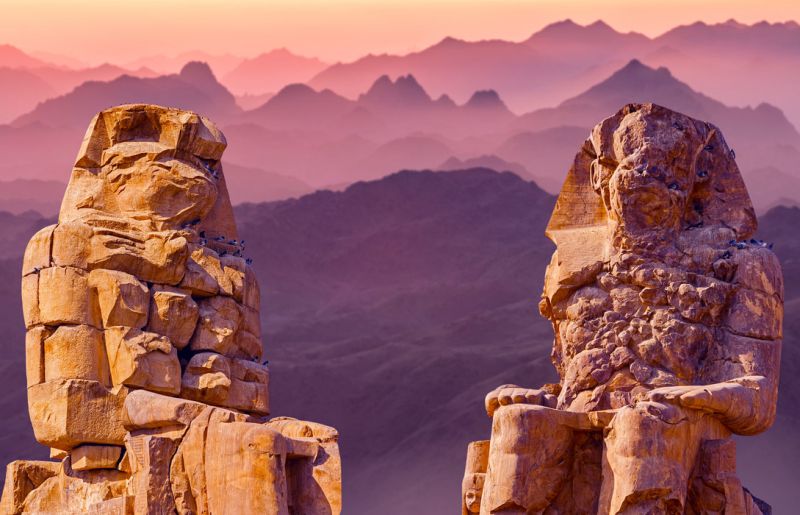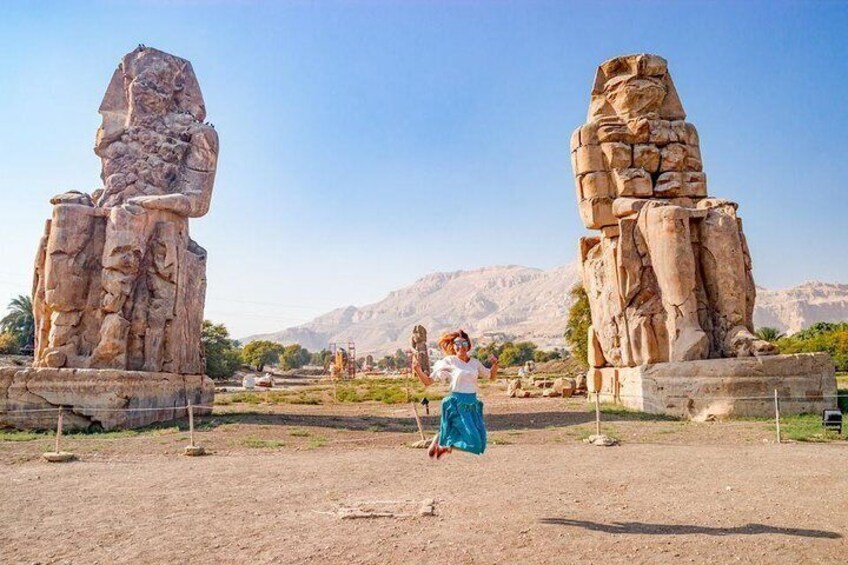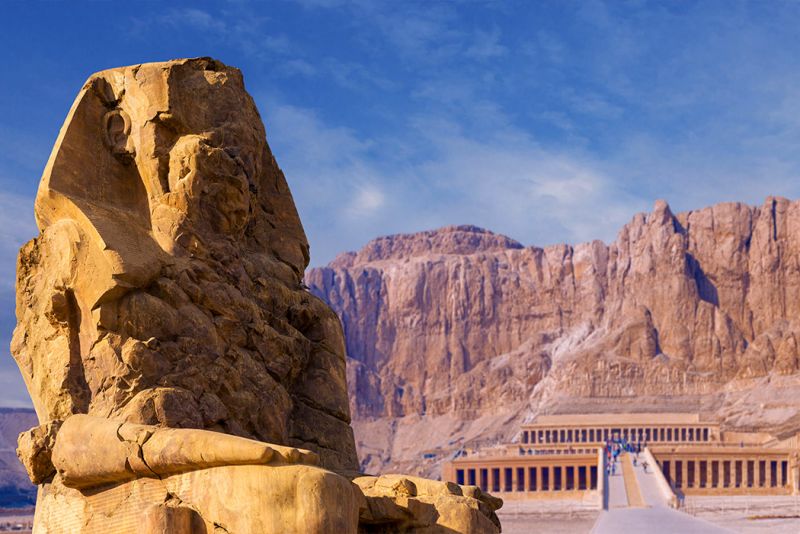The Colossi of Memnon: A Guide to Visiting This Ancient Egyptian Wonder
May 31
Nestled between the inundated fields of tall crops and the wondrous temples of ancient Egypt stands a set of giant statues that have managed to withstand the test of time. These statues, famously known as the Colossi of Memnon, have stood tall for over 3,400 years and continue to awe visitors with their impressive size and intricate detailing. As one of the most significant relics left behind by the Pharaonic civilization, the Colossi of Memnon attracts thousands of visitors yearly. But with so much history and significance attached to them, how do you ensure you're making the most of your visit? In this guide, we'll dive deep into the history of the Colossi of Memnon and offer advice on planning the perfect visit to this ancient Egyptian wonder.

What are the Colossi of Memnon?
Are you planning a trip to Luxor, Egypt? One of the must-see attractions is the Colossi of Memnon. These twin statues are of the pharaoh Amenhotep III and stand at a towering height of 60 feet each. They are located on the West Bank of Luxor and act as guardians to the temple the pharaoh built. Despite the temple's destruction due to natural disasters, the Colossi of Memnon remain strong after thousands of years. [1][2]

Where are the Colossi of Memnon located?
Are you planning a trip to Luxor, Egypt? One of the must-visit attractions is the Colossi of Memnon. These two massive stone statues of Pharaoh Amenhotep III are located in Theban Necropolis, just west of Luxor. They were originally built as guardians for Amenhotep's mortuary complex, which was destroyed by natural disasters. Despite the damage they have faced, the Colossi of Memnon remain an important symbol of Egyptian civilization and culture.
Standing 18 meters tall and weighing around 720 tonnes each, the Colossi of Memnon are awe-inspiring. They are carved from single blocks of quartzite sandstone and depict the seated Amenhotep III on a throne adorned with symbolic engravings. The statues feature imagery of the Nile god and Amenhotep's mother and wife, both symbols of rebirth. The pharaoh is wearing the royal headdress of Nemes, protected by a divine cobra. Despite their age and the natural disasters they have endured, the Colossi of Memnon still offer a glimpse into the grandeur of ancient Egypt.
To visit the Colossi of Memnon, head to Theban Necropolis. The statues are located about half a kilometre east of the Antiquities Inspectorate, which serves as the ticket office for the monument area. The location of the Colossi of Memnon in this vast necropolis can be overwhelming, but they are one of the most famous and important landmarks in the area and can't be missed during your Luxor trip.
The Colossi of Memnon was built during the reign of Amenhotep III, a pharaoh of the 18th Dynasty who lived during the 14th century BC. They were positioned to guard the entrance of the first pylon of his mortuary temple, one of the largest temples built in Egypt. Unfortunately, the temple was destroyed by flooding the Nile and the reuse of its blocks for other building projects. Today, the Colossi of Memnon is a reminder of Amenhotep III's grandeur and his contributions to Egyptian history and culture.
The Colossi of Memnon to your itinerary when planning your visit to Luxor. Located just west of Luxor in Theban Necropolis, these giant stone statues are an important symbol of ancient Egypt. Built during the reign of Amenhotep III, the Colossi of Memnon were positioned as guardians of his mortuary temple, which was unfortunately destroyed. Despite the damage they have faced, these giant statues still offer a glimpse into the grandeur and power of one of ancient Egypt's greatest pharaohs. [3][4]
Standing 18 meters tall and weighing around 720 tonnes each, the Colossi of Memnon are awe-inspiring. They are carved from single blocks of quartzite sandstone and depict the seated Amenhotep III on a throne adorned with symbolic engravings. The statues feature imagery of the Nile god and Amenhotep's mother and wife, both symbols of rebirth. The pharaoh is wearing the royal headdress of Nemes, protected by a divine cobra. Despite their age and the natural disasters they have endured, the Colossi of Memnon still offer a glimpse into the grandeur of ancient Egypt.
To visit the Colossi of Memnon, head to Theban Necropolis. The statues are located about half a kilometre east of the Antiquities Inspectorate, which serves as the ticket office for the monument area. The location of the Colossi of Memnon in this vast necropolis can be overwhelming, but they are one of the most famous and important landmarks in the area and can't be missed during your Luxor trip.
The Colossi of Memnon was built during the reign of Amenhotep III, a pharaoh of the 18th Dynasty who lived during the 14th century BC. They were positioned to guard the entrance of the first pylon of his mortuary temple, one of the largest temples built in Egypt. Unfortunately, the temple was destroyed by flooding the Nile and the reuse of its blocks for other building projects. Today, the Colossi of Memnon is a reminder of Amenhotep III's grandeur and his contributions to Egyptian history and culture.
The Colossi of Memnon to your itinerary when planning your visit to Luxor. Located just west of Luxor in Theban Necropolis, these giant stone statues are an important symbol of ancient Egypt. Built during the reign of Amenhotep III, the Colossi of Memnon were positioned as guardians of his mortuary temple, which was unfortunately destroyed. Despite the damage they have faced, these giant statues still offer a glimpse into the grandeur and power of one of ancient Egypt's greatest pharaohs. [3][4]

When was the Colossi of Memnon built?
The Colossi of Memnon, one of the most popular tourist attractions in Luxor, Egypt, is a pair of twin statues of pharaoh Amenhotep III, accompanied by two smaller statues carved at his feet. It stands graciously on the horizon of the magnificent Luxor horizons. Amenhotep III reigned during the 18th Dynasty from 1386 to 1349 BCE, a time of great prosperity and artistic progress known as the Old Kingdom. 1350 BCE completed the construction of the Colossi of Memnon, as they were built in front of the Pharaoh's temple, a funerary temple to Amenhotep III.
The two colossal statues made of quartzite sandstone were quarried at El-Gabal el-Ahmar, located near modern Cairo, about 420 miles away from ancient Thebes, where they were constructed and remain after thousands of years. Pharaoh Amenhotep's temple was destroyed by an earthquake soon after its completion, and the Colossi of Memnon were constructed as guardians of the temple to protect it from evil. After an earthquake in 27 BCE, the northern colossus statue was partially destroyed and was restored by Roman emperors during the Roman Empire in ancient Egypt.
The Colossi of Memnon is located on the West Bank of Luxor, Egypt, in the Theban Necropolis, where the two statues stand at the entrance of Amenhotep III's mortuary temple. The magnificent Colossi of Memnon gained popularity from its majestic appearance and the mysterious sounds emitted by the northern colossus statue each sunrise. The northern statue, also known as the "Vocal Memnon," cries at dawn, which gave the Colossi of Memnon its modern Arabic name, Kom el-Hatan, and its Roman name, the Temple of Memnon.
The two-seated king statues stand on a throne, ornamented with imagery of Amenhotep's mother, wife, the god Hapy, and other symbolic engravings. Each statue is 60 feet tall, weighing 720 tonnes, and carved from single sandstone blocks. The hands of the king are resting on his knees, and he directs his face towards the east, looking at the sunrise. The two small figures carved into the front of the statues represent his wife, Tiye, and mother, Mutemwiya. Colossi of Memnon symbolizes the king's rule over Egypt, and the three figures on the statues symbolise rebirth.
The Colossi of Memnon remains standing strong for thousands of years, withstanding all the natural disasters that they have faced. They are located about half a kilometre east of the Antiquities Inspectorate on the main road leading to the west bank of the monument area. It is one of the most famous and important places in the Theban Necropolis that cannot be missed during your trip to Luxor, Egypt. The two statues generally refer to the entire Theban Necropolis as the Memnonium, which has remained in common use for the past two thousand years till today. [5][6]
The two colossal statues made of quartzite sandstone were quarried at El-Gabal el-Ahmar, located near modern Cairo, about 420 miles away from ancient Thebes, where they were constructed and remain after thousands of years. Pharaoh Amenhotep's temple was destroyed by an earthquake soon after its completion, and the Colossi of Memnon were constructed as guardians of the temple to protect it from evil. After an earthquake in 27 BCE, the northern colossus statue was partially destroyed and was restored by Roman emperors during the Roman Empire in ancient Egypt.
The Colossi of Memnon is located on the West Bank of Luxor, Egypt, in the Theban Necropolis, where the two statues stand at the entrance of Amenhotep III's mortuary temple. The magnificent Colossi of Memnon gained popularity from its majestic appearance and the mysterious sounds emitted by the northern colossus statue each sunrise. The northern statue, also known as the "Vocal Memnon," cries at dawn, which gave the Colossi of Memnon its modern Arabic name, Kom el-Hatan, and its Roman name, the Temple of Memnon.
The two-seated king statues stand on a throne, ornamented with imagery of Amenhotep's mother, wife, the god Hapy, and other symbolic engravings. Each statue is 60 feet tall, weighing 720 tonnes, and carved from single sandstone blocks. The hands of the king are resting on his knees, and he directs his face towards the east, looking at the sunrise. The two small figures carved into the front of the statues represent his wife, Tiye, and mother, Mutemwiya. Colossi of Memnon symbolizes the king's rule over Egypt, and the three figures on the statues symbolise rebirth.
The Colossi of Memnon remains standing strong for thousands of years, withstanding all the natural disasters that they have faced. They are located about half a kilometre east of the Antiquities Inspectorate on the main road leading to the west bank of the monument area. It is one of the most famous and important places in the Theban Necropolis that cannot be missed during your trip to Luxor, Egypt. The two statues generally refer to the entire Theban Necropolis as the Memnonium, which has remained in common use for the past two thousand years till today. [5][6]

The origin and meaning of the name Colossi of Memnon
When you visit the Colossi of Memnon, you might wonder why this name calls these ancient Egyptian statues. Colossi of Memnon dates back to the Roman era when the statues were known as the "Temple of Memnon." But who was Memnon, and why was his name associated with these magnificent statues? Memnon was a hero of the Trojan War and a king of Ethiopia who fought on the side of the Trojans against the Greeks. He was eventually slain by the Greek champion Achilles, but his courage and battle skill elevated him to a hero among the Greeks. When Greek tourists saw the impressive statues of Pharaoh Amenhotep III, they associated them with the legend of Memnon instead of the king they were meant to honour. The link between the Colossi of Memnon and the hero of the Trojan War was further suggested by the historian Manetho in the third century BCE. [7][8]

What was the purpose of the Colossi of Memnon?
Are you planning to visit Luxor, Egypt? Then, the Colossi of Memnon is a must-visit site. But what was the purpose of these ancient structures? According to historical records, the two massive statues were built during the reign of Pharaoh Amenhotep III and were meant to serve as guardians of his mortuary temple. These statues, built around 1350 BCE, were carved out of quartzite sandstone and transported 420 miles overland to Thebes, where they have remained for thousands of years. Over time, the statues were associated with the Greek hero Memnon, who was said to produce a mysterious sound at every sunrise. Despite their partial destruction during an earthquake in 27 BCE, the Colossi of Memnon stand tall as a testament to the glory of ancient Egypt.
As you approach the Colossi of Memnon, you will be struck by their imposing size. Each statue stands approximately 60 feet tall and weighs 720 tons. The two seated king statues on a throne ornamented with symbolic engravings and the divine cobra are awe-inspiring, and their presence can be felt across the horizon. One of the statues is said to produce a particular sound during sunrise, which added to the statue's mystique and led to the association with the Greek hero Memnon. The statues were meant to symbolize the rule of Pharaoh Amenhotep III over Egypt, and the three figures on the statues of the pharaoh, his wife, and his mother are all symbols of rebirth.
While the Colossi of Memnon are awe-inspiring, they also represent the achievements of Pharaoh Amenhotep III and his reign. Amenhotep III was one of the greatest pharaohs of ancient Egypt and was responsible for some of the most impressive buildings in the country, including his mortuary complex, the largest and most significant building constructed during his reign. This complex, which included numerous rooms, halls, and plateaus, symbolized the Field of Reeds, the Egyptian paradise. Even though a severe earthquake destroyed the complex, the Colossi of Memnon remain a testament to the pharaoh's glory.
The Colossi of Memnon are impressive structures representing the guardians of Pharaoh Amenhotep III's mortuary complex. They are symbols of his greatness and the achievements of ancient Egypt. As you walk around these colossal statues, please take a moment to imagine the grandeur and glory of ancient Egypt they witness daily. [9][10]
As you approach the Colossi of Memnon, you will be struck by their imposing size. Each statue stands approximately 60 feet tall and weighs 720 tons. The two seated king statues on a throne ornamented with symbolic engravings and the divine cobra are awe-inspiring, and their presence can be felt across the horizon. One of the statues is said to produce a particular sound during sunrise, which added to the statue's mystique and led to the association with the Greek hero Memnon. The statues were meant to symbolize the rule of Pharaoh Amenhotep III over Egypt, and the three figures on the statues of the pharaoh, his wife, and his mother are all symbols of rebirth.
While the Colossi of Memnon are awe-inspiring, they also represent the achievements of Pharaoh Amenhotep III and his reign. Amenhotep III was one of the greatest pharaohs of ancient Egypt and was responsible for some of the most impressive buildings in the country, including his mortuary complex, the largest and most significant building constructed during his reign. This complex, which included numerous rooms, halls, and plateaus, symbolized the Field of Reeds, the Egyptian paradise. Even though a severe earthquake destroyed the complex, the Colossi of Memnon remain a testament to the pharaoh's glory.
The Colossi of Memnon are impressive structures representing the guardians of Pharaoh Amenhotep III's mortuary complex. They are symbols of his greatness and the achievements of ancient Egypt. As you walk around these colossal statues, please take a moment to imagine the grandeur and glory of ancient Egypt they witness daily. [9][10]
